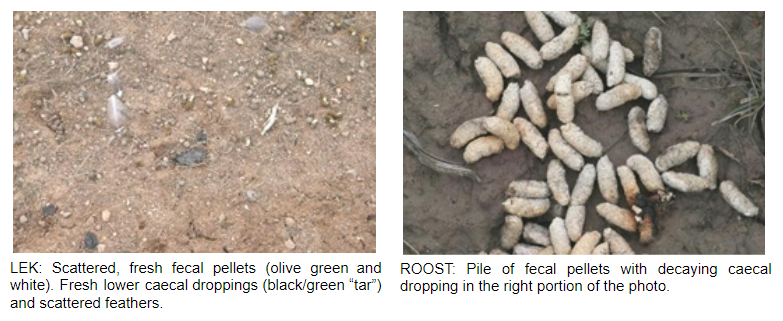It’s true, and the types depend on what they eat!
Sage grouse eat sagebrush and other foods through the spring, summer and fall, but in winter, their diet is 100% sagebrush leaves. Sagebrush leaves contain a chemical called “terpenes,” the aromatic compounds found in many plants. Terpenes are toxic in high concentrations, so in the sage grouse's gut, terpenes are separated and stored in the cecum, a pouch in the lower stomach. Terpenes are excreted separately as caecal droppings which look like black tar the size of silver dollars. Caecal droppings are initially green, but cure to black quickly in the sun; they usually decay within days or weeks depending on precipitation. They are found most often in the winter and early spring when the diet is still purely sagebrush.
The rest of the sagebrush plant, and everything else sage grouse eat, are excreted out as fecal pellets. Those pellets are cylindrical and various shades of olive green fading to white. Fecal droppings can last for years, though they fade with time. Some people think they look like white Cheetos.
Most other animals don’t live on a 100% sagebrush diet, but mix sagebrush with other plants to dilute the terpenes. The pictures show the difference between droppings seen on a lek (along with feathers and tracks) versus droppings near a roosting (sleeping) site.

Sage grouse eat sagebrush and other foods through the spring, summer and fall, but in winter, their diet is 100% sagebrush leaves. Sagebrush leaves contain a chemical called “terpenes,” the aromatic compounds found in many plants. Terpenes are toxic in high concentrations, so in the sage grouse's gut, terpenes are separated and stored in the cecum, a pouch in the lower stomach. Terpenes are excreted separately as caecal droppings which look like black tar the size of silver dollars. Caecal droppings are initially green, but cure to black quickly in the sun; they usually decay within days or weeks depending on precipitation. They are found most often in the winter and early spring when the diet is still purely sagebrush.
The rest of the sagebrush plant, and everything else sage grouse eat, are excreted out as fecal pellets. Those pellets are cylindrical and various shades of olive green fading to white. Fecal droppings can last for years, though they fade with time. Some people think they look like white Cheetos.
Most other animals don’t live on a 100% sagebrush diet, but mix sagebrush with other plants to dilute the terpenes. The pictures show the difference between droppings seen on a lek (along with feathers and tracks) versus droppings near a roosting (sleeping) site.
Publish Date
Answered By
Leslie Schreiber
Job Title
Sage grouse and sagebrush biologist
Photo
Leslie2
Ask Game ID
295
Node order
19
Parent Node
1135
